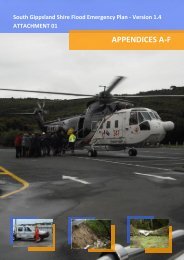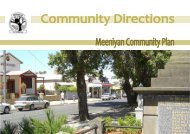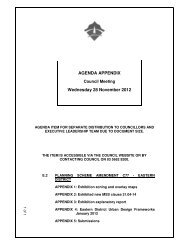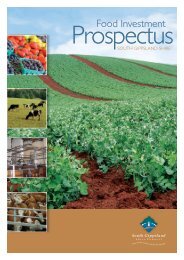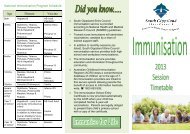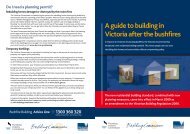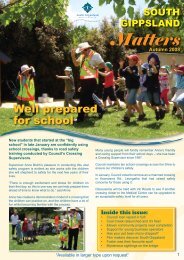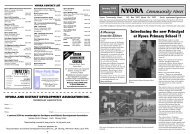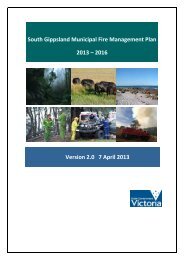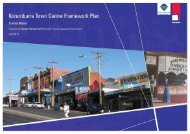Serrated Tussock - South Gippsland Weeds
Serrated Tussock - South Gippsland Weeds
Serrated Tussock - South Gippsland Weeds
You also want an ePaper? Increase the reach of your titles
YUMPU automatically turns print PDFs into web optimized ePapers that Google loves.
Targeting Invasive WoNS in West<br />
<strong>Gippsland</strong> with Community Action<br />
FAST FACT:<br />
Being similar in appearance to many<br />
native tussock grasses, serrated tussock is<br />
able to go unnoticed in both pastures and<br />
native grasslands for many years until<br />
significant infestations<br />
have developed.<br />
<strong>Serrated</strong> <strong>Tussock</strong> floret and fruit (seed). Photo<br />
courtesy of<br />
Julia Scher, USDA APHIS PPQ, Bugwood.org<br />
<strong>Serrated</strong> <strong>Tussock</strong><br />
Fact sheet<br />
weeds of national significance “WoNS”<br />
“Targeting Invasive WoNS in West <strong>Gippsland</strong> with Community Action” is a project funded<br />
by the Australian Government’s Caring for Our Country Program. This project addresses<br />
<strong>Weeds</strong> of National Significance (WoNS) national priorities through the actions of community<br />
Landcare Members, Landcare Groups and Landcare Networks in the WGCMA region.<br />
Invasive WoNS pose a serious threat to agricultural production, environmental health and<br />
biodiversity. Reducing the infestation and spread of WoNS is important to ensure the security<br />
of our farming resource base and our unique environment into the future.<br />
This project addresses national priorities through community partnerships to deliver targeted<br />
action at the local level. Invasive WoNS will be targeted in areas of high significance using<br />
best practice techniques and actions.<br />
why should I worry about serrated tussock<br />
<strong>Serrated</strong> tussock (Nassella trichotoma) is the worst perennial grass weed in Australia; able<br />
to adapt to drier grassland areas. <strong>Serrated</strong> tussock seeds are prolific, long lasting and spread<br />
via wind, livestock, vehicles and farm machinery creating a significant and on-going risk<br />
to agricultural and natural environments. <strong>Serrated</strong> tussock grows vigourously but has little<br />
grazing value because of its high fibre and low protein content. Where dense infestations<br />
dominate pasture a significant loss of livestock production occurs. In native grasslands serrated<br />
tussock competes with native species, significantly reducing biodiversity. It also increases the<br />
severity of wild fires and associated property losses. It can tolerate extremes of temperature,<br />
low rainfall and low soil fertility, so it is well suited to rapidly advance over new areas in<br />
<strong>Gippsland</strong>, colonising bare patches of ground and changing landscapes forever. With climate<br />
change potentially causing higher temperatures, lower rainfall and drought conditions; areas<br />
of <strong>Gippsland</strong> could be at risk from this weed.<br />
1 u 2 u 3 u<br />
4 u<br />
<strong>Serrated</strong> tussock seeds. Note off centre awn<br />
attachment. Photo courtesy of<br />
Julia Scher, USDA APHIS PPQ, Bugwood.org<br />
what does it look like<br />
<strong>Serrated</strong> tussock is a perennial grass that can grow up to 60 cm in height and 25 cm in<br />
diameter at the base of the plant. When in flower, the drooping seed heads can give the plant<br />
an overall diameter of up to 75 cm. The purple colour of small seeds produces an overall<br />
purplish haze to the serrated tussock seed head. Once the seeds have formed, the entire<br />
seed head will ‘droop’ over the tussock towards the ground. Plants growing in fertile soils<br />
are capable of growing to 60 cm high while plants growing in infertile conditions are more<br />
likely to reach a height of only 15 cm. <strong>Serrated</strong> tussock growing in Victoria will generally<br />
be smaller in height than serrated tussock growing in NSW, ACT or Tasmania. It has an<br />
extensive network of fibrous roots which exist mostly in the top 20 cm of soil, although some<br />
do occur deeper. They are dense, wiry and fibrous, making serrated tussock very difficult to<br />
pull out even when small.
have I got serrated tussock at my place<br />
Key identifying features of serrated tussock:<br />
• <strong>Tussock</strong>y grass to 60 cm tall. Plants appear purple when flowering in late spring/early summer. Once the seed ripens in late summer,<br />
flower heads change to a golden brown colour with a light green tussock base. Plants remain green during summer, when other<br />
grasses have usually browned off. Some older leaves may die and remain beige on the plant for several years.<br />
• Thin, tightly rolled, hairless leaves with very fine serrations. <strong>Serrated</strong> tussock leaves roll smoothly like a needle when rolled between<br />
the index finger and thumb. Native grasses will feel like they have flat edges.<br />
• The ligule of serrated tussock is continuous with the leaf sheath, is small (1 mm long), white, has a rounded tip and is never hairy.<br />
Most grasses that are confused with serrated tussock have hairy ligules. To find the ligule, trace down a leaf to its junction with the<br />
stem. Carefully separate and bend the leaf back. If the grass has a ligule it is a small, membranous or hairy flap that protrudes.<br />
• White swollen leaf bases<br />
• The seed head is a multi-branched stem up to 35 cm long. It has two or three branches at each junction and one seed at the end of<br />
each branch.<br />
• Once the seed has ripened, the entire flowering stem will break off from the base of the plant and blow in the wind for dispersal.<br />
• Difficult to pull from the ground, even when small due to the extensive fibrous root system.<br />
how can I deal with it<br />
Dealing with serrated tussock requires an integrated approach. Your local Landcare staff are available to help you develop an Integrated<br />
Weed Management Plan. It is important you obtain help first - it is unlikely you are affected in isolation, so developing a whole of area<br />
control plan in partnership with your neighbours and responsible agencies is essential.<br />
The key principles of Integrated Weed Management to keep in mind are:<br />
• early intervention<br />
• prevent establishment & spread; quickly eradicate new, small or outlying infestations.<br />
• develop a plan utilising appropriate management tactics. <strong>Serrated</strong> tussock plants are most vulnerable as young seedlings as they are<br />
small, slow growing and vulnerable to competition; maintaining ground cover and re-establishing ground cover after herbicide use is<br />
important. Chipping or spraying larger plants prior to flowering stops the formation of tens of thousands of seeds.<br />
• Use prevention strategies such as mesh fencing to catch blowing seed heads, shelterbelts and vehicle hygiene in managing serrated<br />
tussock.<br />
• Regularly monitor areas at high risk of invasion, such as fence lines.<br />
Your Landcare staff can advise you on the recommended herbicides to use on serrated tussock. They will help you develop a control<br />
program and advise you on the best time to spray, follow up and re-vegetate the serrated tussock affected area.<br />
where can I get further help<br />
SOUTH GIPPSLAND LANDCARE NETWORK<br />
Cnr Bair and Young Street, Leongatha (PO Box 419 Leongatha 3953)<br />
Contact Kate Williams on Phone (03) 5662 5759 or email katew@wgcma.vic.gov.au www.southgippslandweeds.com<br />
MAFFRA AND DISTRICT LANDCARE NETWORK<br />
WGCMA Maffra Depot, Malmo Street, Maffra (PO Box 1374, Traralgon, 3844).<br />
Contact: Pest Plant and Animal Officer on Phone 1300 094 262; email: maffralandcareoffice@gmail.com.<br />
BASS COAST LANDCARE NETWORK<br />
PO Box 272, Cowes, 3922; Phone (03) 5678 2235<br />
Contact Matt Stephenson; Phone: (03) 5951 3327; Mobile: 0434 676 064; email: m.stephenson@basscoast.vic.gov.au<br />
LATROBE CATCHMENT LANDCARE NETWORK<br />
16 Hotham Street, Traralgon, 3844 (PO Box 1374, Traralgon, 3844)<br />
Contact Andrew Wolstenholme on Phone 1300 094 262; email: andreww@wgcma.vic.gov.au<br />
3844)<br />
YARRAM YARRAM LANDCARE NETWORK<br />
Livingston Street, Yarram 3971; Phone (03) 5182 5073 Fax (03) 5182 6094<br />
Contact Samantha Monks on Phone: 03 5175 7895; Mobile: 0419 371 497; email: samantham@wgcma.vic.gov.au<br />
We are grateful for permission to quote and use images from The <strong>Serrated</strong> <strong>Tussock</strong> Best Practice Manual<br />
(copies available from NSW DPI Bookshop ph: 1800 028 374 )<br />
Bronwen Wicks — National <strong>Serrated</strong> <strong>Tussock</strong> Coordinator is available for help developing regional plans.<br />
Phone: (02) 4828 6632<br />
email: tussock.management@dpi.nsw.gov.au<br />
Web: www.weeds.org.au/wons/serratedtussock




